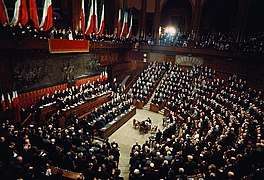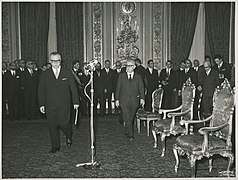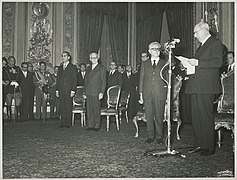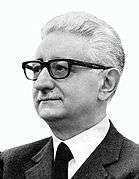1971 Italian presidential election
The Italian presidential election of 1971 was held in Italy on 9–24 December 1971.
| |||||||||||||||||
1,008 voters (320 Senators, 630 Deputies and 58 regional representatives) 673 or 505 votes needed to win | |||||||||||||||||
|---|---|---|---|---|---|---|---|---|---|---|---|---|---|---|---|---|---|
| |||||||||||||||||
| |||||||||||||||||
Only members of Parliament and regional delegates were entitled to vote, most of these electors having been elected in the 1968 general election and in the 1970 regional elections. As head of state of the Italian Republic, the President has a role of representation of national unity and guarantees that Italian politics comply with the Italian Constitution, in the framework of a parliamentary system.
On 24 December 1971 former Prime Minister and President of the Chamber of Deputies Giovanni Leone was elected President with 518 votes out of 1,008, the smallest majority ever obtained by an elected President. With twenty-three rounds of voting this presidential election remains still today the longest presidential election in the Italian republican history.
Procedure
In accordance to the Italian Constitution, the election was held in the form of a secret ballot, with the Senators and the Deputies entitled to vote. The election was held in the Palazzo Montecitorio, home of the Chamber of Deputies, with the capacity of the building expanded for the purpose. The first three ballots required a two-thirds majority of the 1,008 voters in order to elect a president, or 673 votes. Starting from the fourth ballot, an absolute majority was required for candidates to be elected, or 505 votes. The presidential mandate lasts seven years.
The election was presided over by the President of the Chamber of Deputies Sandro Pertini, who proceeded to the public counting of the votes, and by the President of the Senate Amintore Fanfani.
Proposed nominees
- Francesco De Martino, former secretary of Italian Socialist Party, was the first proposal of the left-wing opposition parties;
- Amintore Fanfani, one of the most important leaders of Christian Democracy, was initially proposed by the centre-left government;
- Giovanni Leone, whose nomination emerged only since the twenty-second round of voting;
- Pietro Nenni, former partisan and leader of the socialists, proposed by left-wing parties at penultimate round of voting.
Chronology
The period or the late 1960 – 1970s came to be known as the Opposti Estremismi, (from left-wing and right-wing extremists riots), later renamed anni di piombo ("years of lead") because of a wave of bombings and shootings — the first victim of this period was Antonio Annarumma, a policeman, killed on 12 November 1969 in Milan during a left-wing demonstration. In December 1969, four bombings struck in Rome the Monument of Vittorio Emanuele II (Altare della Patria), the Banca Nazionale del Lavoro, and in Milan the Banca Commerciale and the Banca Nazionale dell'Agricoltura. The later bombing, known as the Piazza Fontana bombing of 12 December 1969, killed 16 and injured 90. Social protests, in which the student movement was particularly active, shook Italy during the 1969 autunno caldo (Hot Autumn), leading to the occupation of the Fiat factory in Turin.
In December 1970, a neo-fascist coup, dubbed the Golpe Borghese, was planned by young far-right fanatics, elderly veterans of Italian Social Republic, and supported by members of the Corpo Forestale dello Stato, along with right-aligned entrepreneurs and industrialists. The "Black Prince", Junio Valerio Borghese, took part in it. The coup, called off at the last moment, was discovered by the newspaper Paese Sera, and publicly exposed three months later.[1]
In this extremely difficult context for republican institutions, on 9 December 1971 Italian Parliament convened to elect a new President. As a result of the 1968 general election, left-wing parties had now more representatives in the Parliament, while Christian Democracy had shrunk its numbers, making it more difficult to elect the new President without the help of its centre-left allies.
After a long voting period which lasted almost two weeks, the Christian democrat Giovanni Leone managed to be elected President with the votes of the Christian Democracy and the neo-fascist Italian Social Movement, facing the extreme opposition of the left-wing parties.
Results
| Candidate | First round 9 Dec 1971 |
Second round 9 Dec 1971 |
Third round 10 Dec 1971 |
Fourth round 11 Dec 1971 |
Fifth round 12 Dec 1971 |
Sixth round 12 Dec 1971 |
Seventh round 13 Dec 1971 |
Eight round 13 Dec 1971 |
Ninth round 14 Dec 1971 |
|---|---|---|---|---|---|---|---|---|---|
| Francesco De Martino | 397 | 398 | 404 | 411 | 399 | 413 | 408 | 411 | 407 |
| Amintore Fanfani | 384 | 368 | 384 | 377 | 385 | 378 | – | – | – |
| Giovanni Malagodi | 49 | 50 | 50 | 50 | 51 | 48 | 50 | 52 | 47 |
| Giuseppe Saragat | 45 | 46 | 51 | 50 | 51 | 50 | 51 | 50 | 55 |
| Augusto De Marsanich | 42 | 39 | 38 | 42 | 43 | – | – | – | – |
| Mariano Rumor | – | – | – | – | – | 6 | – | – | – |
| Other candidates | 12 | 8 | 4 | 3 | 4 | 7 | 2 | 2 | 4 |
| Blank papers | 57 | 77 | 62 | 64 | 62 | 91 | 51 | 48 | 48 |
| Invalid papers | 1 | – | – | – | – | 3 | – | 1 | 2 |
| Abstentions | 21 | 22 | 15 | 11 | 13 | 12 | 446 | 444 | 445 |
| Total | 1,008 | 1,008 | 1,008 | 1,008 | 1,008 | 1,008 | 1,008 | 1,008 | 1,008 |
| Candidate | Tenth round 14 Dec 1971 |
Eleventh round 15 Dec 1971 |
Twelfth round 15 Dec 1971 |
Thirteenth round 16 Dec 1971 |
Fourteenth round 17 Dec 1971 |
Fifteenth round 18 Dec 1971 |
Sixteenth round 18 Dec 1971 |
Seventeenth round 19 Dec 1971 |
|---|---|---|---|---|---|---|---|---|
| Francesco De Martino | 404 | 407 | 394 | 407 | 406 | 400 | 393 | 397 |
| Amintore Fanfani | – | 393 | – | – | – | – | 6 | 5 |
| Giovanni Malagodi | 48 | 48 | – | – | – | – | – | – |
| Giuseppe Saragat | 56 | 56 | 48 | 49 | 49 | 42 | – | – |
| Pietro Nenni | – | – | – | – | – | – | 7 | – |
| Sandro Pertini | – | – | – | – | – | – | 5 | 7 |
| Other candidates | 3 | 22 | 14 | 9 | 5 | 9 | 3 | 6 |
| Blank papers | 50 | 60 | 62 | 48 | 15 | 19 | 10 | 13 |
| Invalid papers | 2 | 2 | 1 | 1 | – | 2 | 1 | – |
| Abstentions | 445 | 20 | 490 | 494 | 533 | 536 | 583 | 580 |
| Total | 1,008 | 1,008 | 1,008 | 1,008 | 1,008 | 1,008 | 1,008 | 1,008 |
| Candidate | Eighteenth round 20 December 1971 |
Nineteenth round 21 December 1971 |
Twentieth round 21 December 1971 |
Twenty-first round 22 December 1971 |
Twenty-second round 23 December 1971 |
Twenty-third round 24 December 1971 |
|---|---|---|---|---|---|---|
| Francesco De Martino | 402 | 390 | 402 | 400 | – | – |
| Giuseppe Saragat | – | – | – | – | 7 | – |
| Pietro Nenni | – | 9 | – | – | 408 | 408 |
| Sandro Pertini | 7 | 10 | – | 6 | 6 | 6 |
| Giovanni Leone | – | – | – | – | 503 | 518 |
| Other candidates | 7 | 6 | 10 | 7 | 19 | 25 |
| Blank papers | 12 | 17 | 15 | 17 | 46 | 36 |
| Invalid papers | – | – | – | – | 2 | 3 |
| Abstentions | 579 | 576 | 581 | 578 | 17 | 12 |
| Total | 1,008 | 1,008 | 1,008 | 1,008 | 1,008 | 1,008 |
| Source: Presidency of the Republic | ||||||
Inauguration
Giovanni Leone officially sworn in as the new President of Italy on 29 December 1971.
Gallery
 Leone taking the oath in front of the Parliament
Leone taking the oath in front of the Parliament Leone arrives at the Quirinal Palace for the swearing in ceremony
Leone arrives at the Quirinal Palace for the swearing in ceremony Leone and Saragat during the swearing in ceremony
Leone and Saragat during the swearing in ceremony
References
- Montanelli, Indro; Mario Cervi (1991). L'Italia degli anni di piombo. Milan, Lombardy, Italy: Rizzoli Editore.
